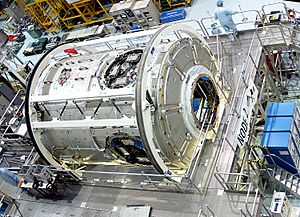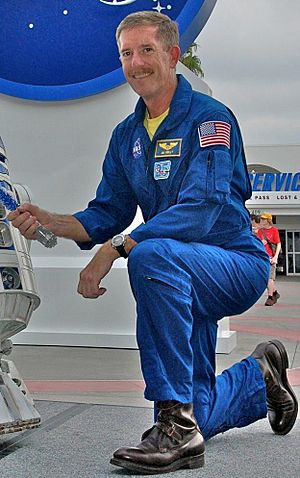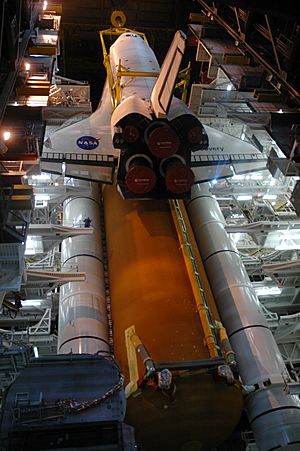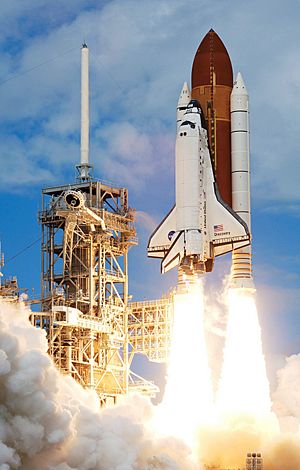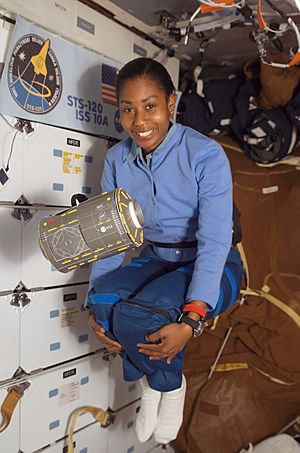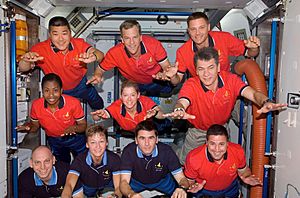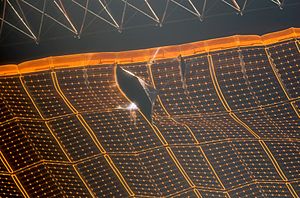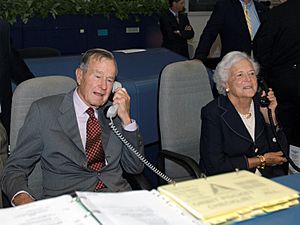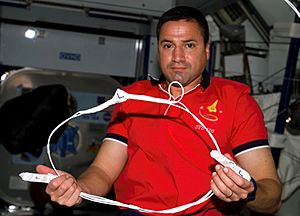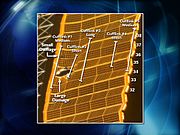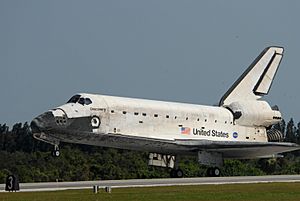STS-120 facts for kids
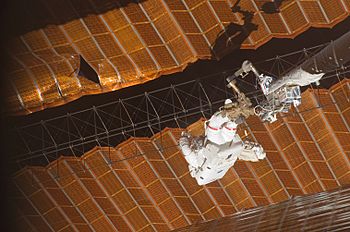
Astronaut Scott Parazynski fixes a torn solar panel on the International Space Station.
|
|
| Mission type | ISS assembly |
|---|---|
| Operator | NASA |
| Mission duration | 15 days, 2 hours, 24 minutes. |
| Distance travelled | 10,060,000 kilometres (6,250,000 mi) |
| Orbits completed | 238 |
| Spacecraft properties | |
| Spacecraft | Space Shuttle Discovery |
| Launch mass | 129,823 kilograms (286,211 lb) |
| Landing mass | 91,578 kilograms (201,895 lb) |
| Crew | |
| Crew size | 7 |
| Members |
|
| Launching |
|
| Landing | |
| Start of mission | |
| Launch date | 23 October 2007, 15:38:19 UTC |
| Launch site | Kennedy LC-39A |
| End of mission | |
| Landing date | 7 November 2007, 18:01:18 UTC |
| Landing site | Kennedy SLF Runway 33 |
| Orbital parameters | |
| Reference system | Geocentric |
| Regime | Low Earth |
| Perigee | 340 kilometres (210 mi) |
| Apogee | 344 kilometres (214 mi) |
| Inclination | 51.6 degrees |
| Period | 91.6 minutes |
| Docking with ISS | |
| Docking port | PMA-2 (Destiny forward) |
| Docking date | 25 October 2007 12:40 UTC |
| Undocking date | 5 November 2007 10:32 UTC |
| Time docked | 10 days, 21 hours, 52 minutes |
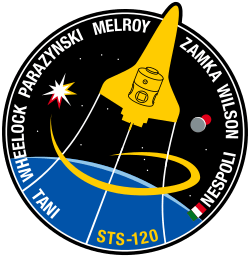  (left to right) Parazynski, Wheelock, Wilson, Zamka, Melroy, Tani and Nespoli |
|
STS-120 was a Space Shuttle mission to the International Space Station (ISS). It launched on October 23, 2007, from the Kennedy Space Center in Florida. This mission was also known as ISS-10A by the ISS program. The main goal of STS-120 was to deliver the Harmony module. It also helped prepare the space station for future parts to be added. The mission used the Space Shuttle Discovery (also known as Space Shuttle Discovery). It was the 23rd Space Shuttle mission to visit the ISS.
Contents
- Meet the STS-120 Crew
- What the Mission Carried: Payloads
- Mission Details and Preparations
- Mission Timeline: Day by Day
- Day 1: Launch Day! (October 23)
- Day 2: Checking the Shuttle (October 24)
- Day 3: Arriving at the ISS (October 25)
- Day 4: Installing Harmony (October 26)
- Day 5: Opening Harmony (October 27)
- Day 6: Spacewalk and SARJ Inspection (October 28)
- Day 7: Moving the P6 Truss (October 29)
- Day 8: Solar Array Problem (October 30)
- Day 9: Planning the Repair (October 31)
- Day 10: Building Repair Tools (November 1)
- Day 11: Final Preparations for Repair (November 2)
- Day 12: The Solar Array Repair! (November 3)
- Day 13: Saying Goodbye (November 4)
- Day 14: Leaving the Station (November 5)
- Day 15: Getting Ready for Landing (November 6)
- Day 16: Landing Back Home! (November 7)
- Spacewalks (Extra-vehicular Activity)
- ESA Esperia Mission Experiments
- Wake-up Calls from Space
- Backup Mission: STS-320
- Images for kids
- See also
Meet the STS-120 Crew
The crew for STS-120 included seven astronauts. They were responsible for flying the shuttle and working on the space station.
| Position | Launching Astronaut | Landing Astronaut |
|---|---|---|
| Commander | Third and last spaceflight |
|
| Pilot | First spaceflight |
|
| Mission Specialist 1 | First spaceflight |
|
| Mission Specialist 2 | Second spaceflight |
|
| Mission Specialist 3 | Fifth and last spaceflight |
|
| Mission Specialist 4 | First spaceflight |
|
| Mission Specialist 5 | Expedition 16 Second and last spaceflight ISS Flight Engineer |
Expedition 16 First spaceflight ISS Flight Engineer |
Original Crew Plans Before 2003
Before the Space Shuttle Columbia accident in 2003, the STS-120 mission was planned differently. The original crew members were:
| Position | Astronaut | |
|---|---|---|
| Commander | James D. Halsell Sixth spaceflight |
|
| Pilot | Alan G. Poindexter First spaceflight |
|
| Mission Specialist 1 | Wendy Lawrence Fourth spaceflight |
|
| Mission Specialist 2 | Stephanie Wilson First spaceflight |
|
| Mission Specialist 3 | Piers Sellers Second spaceflight |
|
| Mission Specialist 4 | Michael Foreman First spaceflight |
|
The mission patch for STS-120 was designed by Michael Foreman. He was later moved to a different mission, STS-123.
What the Mission Carried: Payloads
The Space Shuttle Discovery carried several important items, called payloads, into space. These items were needed to build and improve the International Space Station.
| Location | Cargo | Mass |
|---|---|---|
| Bay 1–2 | Orbiter Docking System EMU 3010 / EMU 3017 |
1,800 kilograms (4,000 lb) |
| Bay 3P | Shuttle Power Distribution Unit (SPDU) |
~100 kilograms (220 lb) |
| Bay 4S | SASA FSE (Fixture for return of S-band Antenna) |
~100 kilograms (220 lb) |
| Bay 5P | Power/Data Grapple Fixture (PDGF) for Node 2 |
~50 kilograms (110 lb) |
| Bay 6S | Main Bus Switching Unit (MBSU) and adapter |
360 kilograms (790 lb) |
| Bay 7P | Shuttle Power Distribution Unit (SPDU) |
~100 kilograms (220 lb) |
| Bay 8–12 | Harmony (Node 2) | 14,288 kilograms (31,500 lb) |
| Sill | OBSS 203 | ~450 kilograms (990 lb) |
| Sill | RMS 301 | ~410 kilograms (900 lb) |
| Total: | 17,300 kilograms (38,100 lb) |
The Harmony Module (Node 2)
STS-120 brought the U.S. Harmony module (also known as Node 2) to the ISS. This module was built in Italy. It was the first new living space added to the station since 2001.
Harmony was installed in two steps. First, it was attached to the Unity module. After Discovery left, the station's robot arm moved a docking port (PMA-2) from Destiny to Harmony. Then, Harmony was moved to its final spot on the front of Destiny.
This new module was very important. It allowed for the future addition of other research modules. These included Europe's Columbus and Japan's Kibō.
Moving the P6 Solar Arrays
During STS-120, the large P6 solar arrays were moved. They were taken from their temporary spot on top of the Unity module. Then, they were moved to their permanent location at the end of the station's main truss. This was a big job!
Special Items Flown on the Mission
STS-120 carried signatures from over 500,000 students. These students took part in the 2007 Student Signatures in Space program. Their signatures were put on a disk and flown into space.
Also, a famous lightsaber from the 1983 movie Return of the Jedi flew to the station. It was flown to celebrate the 30th anniversary of the Star Wars movies. The lightsaber was later displayed at Space Center Houston.
Mission Details and Preparations
The STS-120 mission was originally planned for early 2004. However, it was delayed several times. The final launch date was October 23, 2007.
NASA also considered adding a fifth spacewalk. This spacewalk would have tested a new tool to fix the shuttle's heat shield. But problems with a solar array joint (SARJ) and the P6 Solar Array meant this test was postponed.
This mission was special for several reasons:
- It was the 151st NASA crewed spaceflight.
- It was the 120th Space Shuttle flight since STS-1.
- It was the 34th flight of Discovery.
- It was the 7th mission after the Columbia accident.
Getting Ready for Launch

After a previous mission (STS-118), NASA made changes to the external tank for STS-120. They improved the foam insulation to prevent pieces from breaking off during launch. This was important for safety after past incidents.
Discovery had a small delay due to a hydraulic fluid leak. But it was fixed quickly. The shuttle was then moved to the Vehicle Assembly Building (VAB). There, it was attached to its external tank and solid rocket boosters. Finally, Discovery arrived at Launch Complex 39A on September 30, 2007.
The crew arrived at Kennedy Space Center on October 7, 2007. They practiced for the launch in a "Dress Rehearsal." NASA managers checked the shuttle's heat shield panels. They decided it was safe to launch without replacing them.
Mission Timeline: Day by Day
Day 1: Launch Day! (October 23)
Discovery launched exactly on time at 11:38 AM EDT. There was a small piece of ice seen on the external tank. But NASA decided it was too small to be a problem. The weather was good, even though storms were expected. George Lucas, the creator of Star Wars, was there to see the lightsaber off into space!
Day 2: Checking the Shuttle (October 24)
The astronauts spent their first full day in space. They used the shuttle's robot arm and a special boom to check the heat shield. They also prepared their spacesuits for spacewalks. Early checks showed no major problems with Discovery.
Day 3: Arriving at the ISS (October 25)
The crew performed a special maneuver to approach the ISS. Discovery successfully docked with the station at 12:40 PM UTC. After docking, the two crews met. Astronaut Daniel Tani officially joined the ISS crew, and Clayton Anderson returned to the shuttle. Initial photos showed Discovery was in good shape.
Day 4: Installing Harmony (October 26)
The first spacewalk of the mission began. Astronauts Scott Parazynski and Douglas Wheelock worked outside. They prepared the Harmony module to be moved. Inside, astronauts used the station's robot arm to move Harmony out of the shuttle's cargo bay. At 3:38 PM UTC, Harmony was officially attached to the ISS! This new module added a lot of living space to the station.
NASA managers also decided to add a task to the next spacewalk. They wanted astronauts to check a part called the Solar Alpha Rotary Joint (SARJ). This joint had been vibrating.
Day 5: Opening Harmony (October 27)
The crews worked to get Harmony ready to enter. They connected power and data cables. At 12:24 PM UTC, the hatch to Harmony was opened! Astronauts entered wearing masks to help the air circulate. They began removing many screws and bolts that held equipment in place during launch. The crews also held a press conference from inside the new module.
Day 6: Spacewalk and SARJ Inspection (October 28)
The second spacewalk started early. Parazynski and Daniel Tani worked outside. They disconnected parts of the P6 truss, preparing it to be moved. Tani also inspected the vibrating Solar Alpha Rotary Joint (SARJ). He found metal shavings and wear marks inside the joint. This was an important discovery! Managers decided to add another SARJ inspection to a future spacewalk.
Day 7: Moving the P6 Truss (October 29)
The crews moved the P6 truss from the station's robot arm to the shuttle's arm. This prepared it for its final move. Scientists on the ground tested the metal shavings Tani found. They confirmed they were metal. This helped them understand the problem with the SARJ.
Because of the SARJ issue, NASA added an extra day to the mission. The fourth spacewalk would now focus on inspecting the SARJ. Discovery would now undock on November 5 and land on November 7.
Day 8: Solar Array Problem (October 30)
The third spacewalk began. Parazynski and Wheelock attached the P6 solar arrays to the P5 truss. The first set of arrays deployed fine. But during the deployment of the second set (4B), the crew saw a problem. There was a tear in the array! The crew took pictures, and managers on Earth began planning a fix. Even with the tear, the array was still producing most of its power.
Day 9: Planning the Repair (October 31)
The crew worked on various tasks. They installed a storage rack in Harmony. They also talked to the President of Italy and news agencies. Mission control told the crew that the next spacewalk would be delayed. This was to allow time to plan the repair of the damaged solar array.
Day 10: Building Repair Tools (November 1)
Managers decided to take an extra day to plan the repair. The crew spent time building special tools for the spacewalk. One tool was called a "cufflink." This tool was designed to relieve pressure from the torn part of the solar array. It would transfer the load to stronger parts of the array. The crew also talked with former President George H.W. Bush.
Day 11: Final Preparations for Repair (November 2)
The shuttle and station crews spent the day reviewing the new spacewalk plan. They also positioned the station's robot arm. This would allow it to reach the damaged solar array. This spacewalk would be the first time the Orbiter Boom Sensor System (OBSS) was used as a work platform.
Day 12: The Solar Array Repair! (November 3)
The fourth spacewalk began. Astronaut Scott Parazynski was positioned at the end of the robotic arm. He slowly and carefully attached five "cufflinks" to the solar array. Inside the station, the crew slowly deployed the array. At 3:23 PM UTC, the array was fully deployed! It was a successful repair.
After the spacewalk, a pair of pliers floated away from the station. They were not a danger. Parazynski completed his seventh spacewalk, making him one of the top spacewalkers ever.
| Illustration of plan | Repair images | |
|---|---|---|
| The OBSS was used to extend the reach of the Canadarm2. | ||
| The five cufflinks were placed to take pressure off the damaged solar array. |
Day 13: Saying Goodbye (November 4)
The crews spent the day moving cargo and resting. Astronauts Nespoli and Melroy spoke to Italian media. The hatches between the shuttle and station were closed at 8:03 PM UTC. Astronaut Clayton Anderson gave an emotional speech, thanking the ground crew for their support.
Day 14: Leaving the Station (November 5)
The crews prepared for Discovery's departure. At 10:32 AM UTC, the shuttle undocked from the ISS. Pilot George Zamka flew Discovery around the station. This allowed the crew to take photos of the newly configured ISS. After a final engine burn, the crew began checking the shuttle's heat shield one last time.
Day 15: Getting Ready for Landing (November 6)
The crew of Discovery spent the day preparing for landing. They packed items and checked the shuttle's systems. Commander Pamela Melroy performed a small engine burn. This helped fine-tune the shuttle's path for landing. NASA officially cleared Discovery's heat shield for reentry.
Day 16: Landing Back Home! (November 7)
The crew got ready for landing. The weather at Kennedy Space Center looked good. Discovery flew diagonally across the United States. It passed over Vancouver, Canada, and then angled towards Florida.
At 1:01 PM EST, Discovery touched down on Runway 33. The rear landing gear touched first, followed by the nose gear. The shuttle came to a complete stop at 1:02 PM EST. The mission lasted 15 days, 2 hours, 23 minutes, and 55 seconds. Discovery traveled 6.25 million miles in 238 orbits. This was Discovery's longest mission ever!
Spacewalks (Extra-vehicular Activity)
Four spacewalks were completed during STS-120. Astronauts spent a total of 27 hours and 14 minutes working outside the spacecraft.
| EVA | Spacewalkers | Start (UTC) | End | Duration | Mission |
|---|---|---|---|---|---|
| EVA1 | Scott E. Parazynski Douglas H. Wheelock |
26 October 2007 10:02 UTC |
26 October 2007 16:16 UTC |
6 hours, 14 minutes | Preparing Harmony for installation, retrieving an antenna support, disconnecting fluid lines, installing radiator shrouds. |
| EVA2 | Scott E. Parazynski Daniel M. Tani |
28 October 2007 09:32 UTC |
28 October 2007 16:05 UTC |
6 hours, 33 minutes | Disconnecting P6 from Z1, moving P6, configuring a radiator, installing Harmony handrails, inspecting the starboard Solar Alpha Rotary Joint (SARJ). |
| EVA3 | Scott E. Parazynski Douglas H. Wheelock |
30 October 2007 08:45 UTC |
30 October 2007 15:53 UTC |
7 hours, 08 minutes | Attaching P6 to P5, connecting umbilicals, configuring a radiator, inspecting the port SARJ. |
| EVA4 | Scott E. Parazynski Douglas H. Wheelock |
3 November 2007 10:03 UTC |
3 November 2007 17:22 UTC |
7 hours, 19 minutes | Inspecting and repairing the P6 Solar Array. |
ESA Esperia Mission Experiments
Besides helping build the ISS, astronaut Paolo Nespoli also did science experiments for the ESA. His mission was called Esperia. He performed experiments on human physiology and biology. These studies helped scientists learn more about how the human body and living things react to space.
Wake-up Calls from Space
NASA has a fun tradition of playing music to astronauts to wake them up. This started during the Gemini program. Each song is chosen by the astronauts' families or has a special meaning to the crew.
| Flight Day | Song | Artist/Composer | Played for | Links |
|---|---|---|---|---|
| Day 2 | "Lord of the Dance" | John Langstaff | Pamela Melroy | wav mp3 Transcript |
| Day 3 | "Dancing in the Moonlight" | King Harvest | Dan Tani | wav mp3 Transcript |
| Day 4 | "Rocket Man" | Elton John | Douglas Wheelock | wav mp3 Transcript |
| Day 5 | "Bellissime stelle" | Andrea Bocelli | Paolo Nespoli | wav mp3 Transcript |
| Day 6 | "What a Wonderful World" | Louis Armstrong | Scott Parazynski | wav mp3 Transcript |
| Day 7 | "One by One" | Wynton Marsalis | Stephanie Wilson | wav mp3 Transcript |
| Day 8 | "Malagueña Salerosa" | Chingon | George Zamka | wav mp3 Transcript |
| Day 9 | "Nel blu dipinto di blu" | Domenico Modugno | Paolo Nespoli | wav mp3 Transcript |
| Day 10 | "The Lion Sleeps Tonight" | Robert John | wav mp3 Transcript |
|
| Day 11 | "World" | Five for Fighting | Doug Wheelock | wav mp3 Transcript |
| Day 12 | Star Wars | John Williams | Scott Parazynski | wav mp3 Transcript |
| Day 13 | "The Presence of the Lord Is Here" | Byron Cage | Stephanie Wilson | wav mp3 Transcript |
| Day 14 | "Roll Me Away" | Bob Seger | George Zamka | wav mp3 Transcript |
| Day 15 | "Space Truckin'" | Deep Purple | Expedition 15 | wav mp3 Transcript |
| Day 16 | "Chitty Chitty Bang Bang" | Sherman Brothers | Pamela Melroy | wav mp3 Transcript |
Backup Mission: STS-320
STS-320 was a special backup mission. It would have launched if Space Shuttle Discovery had a major problem during STS-120. This mission would have been a changed version of the STS-122 mission. It would have launched quickly, by January 5, 2008, at the latest. A smaller crew of four astronauts from the STS-122 team would have flown this rescue mission.
Images for kids
See also
 In Spanish: STS-120 para niños
In Spanish: STS-120 para niños



